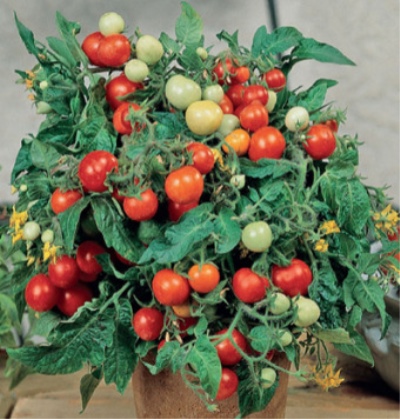
- Authors: Maksimov S.V., Tereshonkova T.A., Klimenko N.N., Kostenko A.N. (Agrofirma POISK LLC
- Year of approval: 2012
- Category: grade
- Growth type: determinant
- Appointment: fresh consumption
- Ripening period: early
- Ripening time, days: 85-90
- Growing conditions: for a balcony, for growing on a windowsill, pot culture, decorative gardening
- Bush size: dwarf
- Bush height, cm: 30-40
In 2012, the Baby tomato was approved for use. Since then, he has gained particular popularity among domestic agronomists. It can even be grown on the balcony, while getting a decent yield from each bush.
Breeding history
The work on the removal of the Baby was carried out in LLC "Agrofirma POISK".
Description of the variety
This variety, if viewed from the standpoint of growth, refers to determinant, therefore it stretches up to 30-40 cm and does not grow any more. The baby tomato can be grown in a pot on the balcony and used as an ornamental plant. When a high-quality harvest is obtained, it is used fresh, since tomatoes of this variety are not suitable for conservation.
Dwarf bushes, small foliage, dark green. This is a standard plant with a simple inflorescence and stem, which has an articulation.
The main qualities of the fruit
In an unripe state, Baby tomatoes are light green, and when ripe, they become bright red. In terms of size, these are cherry tomatoes, the weight is no more than 15 grams. All tomatoes are round and slightly ribbed.
Taste characteristics
The pulp of Baby tomatoes is not very dense, rather average, the taste is sweet.
Ripening and fruiting
The described variety is early, ripens in just 80-90 days after planting the seeds. Already in mid-July, you can start harvesting Baby fruits. Plants cease to bear fruit by the end of August.
Yield
The maximum that can be collected from this dwarf bush is 1.5 kg of tomatoes. Thus, Baby is classified as a high-yielding variety.
The timing of planting seedlings and planting in the ground
You can plant seeds in mid-March, and in May the seedlings will be ready for planting in a single pot.

Growing tomato seedlings is an extremely important process, because it largely depends on whether the gardener will be able to harvest at all. All aspects must be taken into account, from seedbed preparation to planting in the ground.
Landing scheme
If the plant is planted in a greenhouse, then a 50 x 30-40 cm pattern is used.

Growing and care
For growing the Baby variety, it is better to use small pots 7.5-10 cm high, wide enough for the seedlings to spread their roots. Fill the containers almost completely (leaving only about 1 cm of free space on top) with soilless potting mixture or general purpose compost. Several seeds are placed in one pot to a depth of no more than a centimeter. The ground is well watered and covered with a film.
You can put the pots in the greenhouse or on the balcony. A minimum of four hours of direct sunlight is required per day.The more it is, the warmer the environment, respectively, the faster the seeds will germinate. Seedlings will appear in two weeks or less. The film is removed, and after 6-8 weeks the plants can be transplanted into larger pots. During this period, it is imperative to ensure good air circulation for the seedlings, so you can open a window or take out the pots to an open balcony.
Due to the small amount of land, Baby will have to be constantly fed. At the beginning, nitrogen fertilizers, and then potash and phosphorus. You can always use organic matter: bird droppings, manure. To keep moisture in the pot longer, use mulch. It is imperative to make a high-quality drainage system in the container: if it is not there, the water will begin to stagnate, and soon the root system of the plant will become infected with rot. Baby is weakly resistant to this type of disease, so drainage will solve many problems.
Watering adult plants as needed. The soil should always be moist and not dry out, but not wet.




A plant needs different micronutrients at each stage of growth. All fertilizers can be divided into two groups: mineral and organic. Folk remedies are often used: iodine, yeast, bird droppings, eggshells.
It is important to observe the rate and period of feeding. This also applies to folk remedies and organic fertilizers.
Disease and pest resistance
Baby has resistance to:
- tobacco mosaic;
- fusarium wilting.
Greenhouse baby tomatoes are less susceptible to disease than those grown outdoors. You can carry out preventive treatment after planting seedlings. Sulfur and copper based fungicides are used.
However, there are two pests that can spoil the mood quite badly, as they are common in greenhouses and often cause great damage to the crop. They are red spider mites and whiteflies.
It is impossible not to notice a tick on the baby bushes. It is worth fighting it not with pesticides, but with insecticides, since they will kill a natural enemy faster. You can contact your local gardening center and ask them to breed the natural enemy of this insect.
Whiteflies appear in the spring. There is a two-step process for dealing with this insect. At the beginning of April, it is worth introducing a parasitic wasp known as encarsia formosa into the greenhouse, which will eat this insect. Then traps are hung up at the end of the month. Most adults are pesticide resistant.
Growing marigolds near tomatoes will help attract moths if there are aphid problems. Insecticidal soap also helps from it, from which a soapy solution is prepared for spraying.


Growing regions
You can grow Baby in any region of our country: from the southern parts to the Far East.

























































































